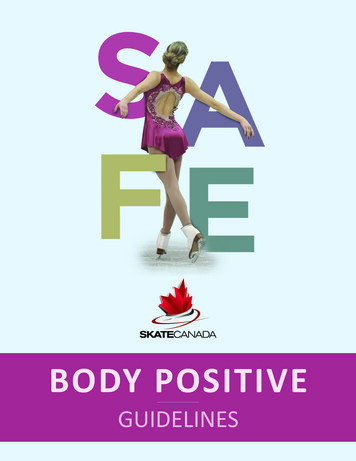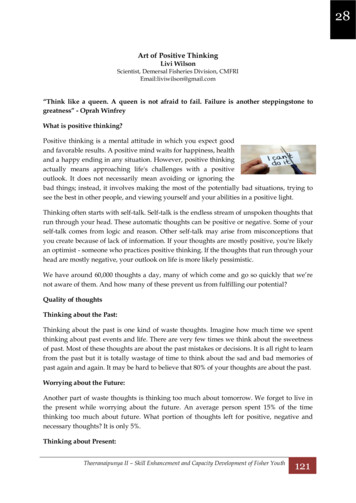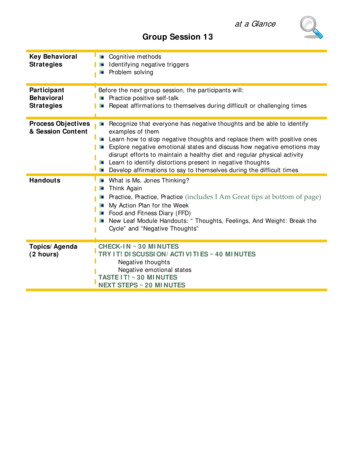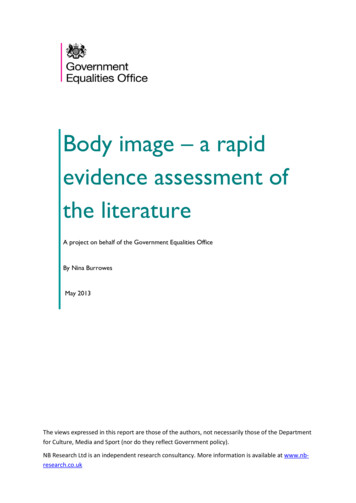
Transcription
Positive Body LanguageAbout the TutorialThis tutorial delineates the fact that body language plays a pivotal role in our day-to-dayactivities and relationships with others. Proper body language is required for building agood rapport and developing good relationships with our friends, colleagues, and familymembers. If we don’t follow the rules of good body language, our repute and chances oflanding into better opportunities can reduce drastically.Improper body language leads to ruined interviews, wrong first impressions, andconveyance of wrong messages. This tutorial details certain tips and techniques todevelop a positive body language and to project oneself in public in a more confident andelegant manner.Body language is not just about hand or leg movements, but also about how we conductourselves when we are at rest. Hence, positive body language is a must for not onlyinterviews or formal discussions but also for functions, parties, and any kind of meetingor interaction we are involved in on a daily basis.AudienceThis tutorial is aimed towards people who are in college or are about to join the corporatesector and also for those professionals working in any different organizations. Individualswho have no knowledge on proper body language can benefit from this tutorial.PrerequisitesThere is no prerequisite for this tutorial. Similarly, there is no barrier of language orethnicity for gaining benefit from this tutorial.Copyright & Disclaimer Copyright 2016 by Tutorials Point (I) Pvt. Ltd.All the content and graphics published in this e-book are the property of Tutorials Point(I) Pvt. Ltd. The user of this e-book is prohibited to reuse, retain, copy, distribute orrepublish any contents or a part of contents of this e-book in any manner without writtenconsent of the publisher.We strive to update the contents of our website and tutorials as timely and as preciselyas possible, however, the contents may contain inaccuracies or errors. Tutorials Point (I)Pvt. Ltd. provides no guarantee regarding the accuracy, timeliness or completeness ofour website or its contents including this tutorial. If you discover any errors on ourwebsite or in this tutorial, please notify us at contact@tutorialspoint.com.i
Positive Body LanguageTable of ContentsAbout the Tutorial . iAudience . iPrerequisites . iCopyright & Disclaimer . iTable of Contents . ii1.INTRODUCTION . 1What is Body Language? . 2What is Sign Language? . 2What is a Positive Body Language? . 32.IMPORTANCE OF BODY LANGUAGE . 4Assertive Behavior . 4Non-verbal Communication . 4Workplace Success . 5Relationships . 5Public Speaking . 63.GOOD STANDING POSTURES . 7Rule 1: Stand Erect . 7Rule 2: Face the Person . 8Rule 3: Free Your Hands. 8Rule 4: Look into the Eyes . 9Rule 5: Move, Yet Mind Your Limbs . 9ii
Positive Body Language4.GOOD SITTING POSTURES . 10Rule 1: Face the Person . 10Rule 2: Look into the Eyes . 10Rule 3: Mind Your Legs . 10Rule 4: Don’t Slouch . 11Rule 5: Scream of Importance . 125.THE PROPER HANDSHAKE . 13The Equality Handshake . 13The Submissive Handshake. 14The Dominant Handshake . 14The Double Handler Handshake . 15The Wet Fish Handshake . 15The Vice Handshake . 16The Bone Breaker Handshake . 16The Fingertip Handshake . 17The Straight Finger Handshake . 176.PROPER HAND MOVEMENTS . 18Rule 1: Open Your Palms . 18Rule 2: Uncross the Arms . 18Rule 3: Don’t Grip Your Arms . 19Rule 4: Zero Arm Barriers . 20Rule 5: Parallel Over Perpendicular . 207.CROSSED LEGS ETIQUETTES . 21The Standing Leg Cross . 21The Double Cross . 22iii
Positive Body LanguageFigure Four Leg Clamp . 23The Ankle Lock . 24The Leg Twine . 24Parallel Legs. 24Dominant Stand . 25Attention Position . 25Basic Do’s and Don’ts . 268.PLEASANT FACIAL EXPRESSIONS. 27An Original Smile Vs. a Fake Smile . 279.WALK SMART . 29Rule 1: Stand Erect and Face Up . 29Rule 2: Use All Muscles . 29Rule 3: Pull Back the Shoulders. 29Rule 4: Get the Correct Pace . 3010. PROPER EYE CONTACT . 31The Dilating and Contracting of Pupils . 31The Eyebrow Flash . 32The Sideways Glance . 33The Magic of Blinking . 3311. MIND YOUR FINGERS . 35Rubbing of Palms . 35Thumb and Finger Rub. 35Clenched Hands . 35The Steeple. 36iv
Positive Body LanguageThe Face Platter . 36Holding Hands Back . 3712. DETECTING LIARS . 3813. VOICE CONTROL . 41Pace . 41Pause . 42Pitch . 4214. SAFE SPACE . 4415. MIRRORING. 4616. SEATING ARRANGEMENTS . 48v
1. IntroductionPositive Body LanguageBody language is defined as the non-verbal communication between two individuals ora group of individuals through physical behaviors such as limb movements, facialexpressions, eye movements, other bodily gestures and postures.Today, the term has assumed so much importance and prominence in all spheres of life thatwithout a positive body language, none of us can survive in the professional arena, personallives, and in the world, in general.Body language comes into picture not only during normal conversations, but also duringformal discussions, interviews, group discussions, panel meetings, etc. Proper bodylanguage not only conveys the right message to the recipient, but also attracts or repels therecipient.For example, you are facing a job interview and the interviewer is questioning you. Now,although you are polite and replying well to the questions, the interviewer may still notselect you. The reason is very simple. Perhaps your body posture or body movements werenot appropriate or were rude. This may have led the interviewer to think that you are eithernot interested, or you are not a good candidate for the job profile.However, body language is different from sign languages. In sign language, words orinformation is conveyed voluntarily using hand and finger movements. In sign language,mostly lip movements, finger movements, palm movements and eye movements are usedto convey information to the recipient of the information. However, body language is1
Positive Body Languagedifferent from sign language in the fact that body language is largely involuntary andis not actively controlled by the mind. However, sign languages are voluntary and arecontrolled by the mind to convey information.What is Body Language?Following are the important features of body language: It is a set of involuntary actions of the body parts. It involves movement, especially of the limbs and the head. It does not have grammar. It has to be interpreted broadly by other people.InvoluntaryAll body partsNo grammarBroadinterpretationWhat is Sign Language?Following are the important features of sign language: It is not the deliberate movement of body parts to convey information. It is hence,not a voluntary action of body parts. It has its own grammar. It has absolute meaning, instead of subjective meaning.2
Positive Body LanguageHowever, this does not mean that if body language is involuntary, it cannot be controlled.By practicing certain techniques mentioned in this tutorial and through careful evaluation ofone’s body movements each time, one can improve one’s body language easily.Body language is quite particular to a specific culture. What is accepted in one culturemay be a big ‘No’ in other cultures. Hence, body language is not universal and can beambiguous too. This tutorial will teach you the essentials of good body language.What is a Positive Body Language?People find positive language appealing, receptive and easy to confront. A positive bodylanguage must place us in a position of comfort, dignity, and likeability. It helps us to beopen to other people and be approachable, helping them feel comfortable when they areinteracting with us. If our body movements somehow convey the opposite, then our bodylanguage is not positive and hence, needs to be improved. Body language must not be defensive. Defensive body language discourages peoplefrom approaching us and establishing a connect with us. Body language must not display a sense of disinterest towards the other person, asit can lead to failure in jobs, interviews and high-profile meetings. The body language of a person must neither be authoritative nor submissive, butassertive to put forth our opinion and stance confidently without meaning any offenceto the other person.ShowconfidenceNodominanceNodisinterestNon defensiveApproachablePositive body language helps people to be liked by other people in an organization orcommunity and is therefore must for people across disciplines and ethnicities, as it plays apivotal role in shaping our discussions and relationships with other people in our daily life.3
Positive Body Language2. Importance of Body LanguageBody language is of utmost importance in this highly competitive world. The corporate sectorvalues good body language a lot and any sign of bad body language can break deals, evenleading to loss of network for people.An old adage says “Actions speak louder than words". Our body posture, along with itsmovements and placement of different body parts, play an important role in letting out ourfeelings and emotions, even if we don’t display the emotions voluntarily.Assertive BehaviorA positive body language helps the person to be more assertive and assists in putting hisor her opinion forward more easily than the others. Positive body language is liked by otherpeople and hence, the person carrying a positive body language gets more attention andfavor in any discussion.Non-verbal CommunicationResearch says that our communication consists of 35% verbal communication and 65%non-verbal communication. This implies that whatever we speak voluntarily comprisesof just 35% of what the other person makes out of us. The remaining 65% informationabout us is learnt from our body language. Our body language helps others identify ouremotions, status and even our lifestyle.4
Positive Body LanguageNon-verbal communication plays a significant role in conjunction with the spoken words.Our non-verbal communication can reiterate our message, contradict our words,reinforce our statement, substitute the meaning of our sentences and complement themeaning of our words. Since non-verbal communication can either emphasize our point orcontradict it, it is necessary to keep our body language in sync with our emotions. Any signof conflict between the body language and our words can make us appear untrustworthyand deceptive.Workplace SuccessPositive body language is a must in workplaces and corporate environment. Healthy bodylanguage can help foster team spirit in the workplace, which can also boost the moraleof the employees. Delegation of responsibilities becomes easier through positive bodylanguage. It can also help in conveying respect for colleagues and resolving conflicts inthe organization.During corporate meetings, one can display interest, reception, and joy using positive bodylanguage. A gentle smile, open palms, leaning forward and eye contact can go a longway in establishing rapport with another person in the meeting thus helping build andsustain a healthy relationship with the other parties in a meeting.RelationshipsNegative body language can give way to a lot of misinterpretation and misunderstandings.Maintaining a body posture and absurd body movements that is offensive to the otherperson can ruin a relationship.For instance, you need to understand the emotions and mood of the other person and needto customize your behavior accordingly. If your spouse is in a good mood, then it is okay to5
Positive Body Languagelaugh or tease her occasionally. However, the same activity can be misinterpreted assarcasm or irritable behavior if the spouse is not in a good mood. This can lead to issuesbetween couples and can also lead to damaged relationships.Public SpeakingIn public speaking, body language assumes an altogether different importance. If thespeaker has a defensive body language or has a passive body language, there are highchances that he or she won’t be listened to intently by the audience. The impact factor ofsuch speeches also is reduced by a large fraction as the audience gets 35% of the entirecommunication but misses the remaining 65%. Hence, it’s highly important to haveproper body movements and posture while speaking on stage in front of an audience.Body language is very important in all forms of communication. It helps to break the barrierof unfamiliarity and helps to form a better connect with the recipient of information.6
Positive Body Language3. Good Standing PosturesMost of the times when we meet people, we are standing in front of them. Be it a casualmeeting on the roadside or meeting someone in the office or having a conversation with afriend at a party, many of the conversations in our life happens in a standing position.Following are the important postures to look for while standing and having a conversation.Rule 1: Stand ErectThe first point to be kept in mind is to stand with the spine erect. The back must bestraight as this gives an impression of being tall. A taller appearance creates goodimpression as well. You must not slouch or hunch.Hunching or slouching gives an impression of laziness and lethargy. A person won’tlike to approach you to talk if you appear to be weak or lethargic. Active personality isalways preferred by people. Bad standing posture also symbolizes low self-esteem. This isnot a good attribute to sport while standing.7
Positive Body LanguageRule 2: Face the PersonThe second point to remember is to not face sideways from your listener. Try to standfacing the person who you are communicating with. Standing sideways shows that youwant to run away from the person and don’t want to continue talking. Watch out for thesame signals from the other person as well. If that person is standing sideways, please stopthe conversation as soon as possible. This is because the other person is not interested inthe conversation.The best way to stand is to direct your heart towards the other person. Ensure thatyour heart faces the heart of the other person without any obstruction in between. Standingwith arms crossed over the chest is also a big ‘No’. It is better to stand akimbo or withyour hands over your waist. Having crossed arms symbolizes defensive position orintrovert nature. This type of attitude is seldom liked by people and it puts most of thepeople off.Rule 3: Free Your HandsThe third point to be careful about is to not put your hands inside your pockets, whiletalking to someone. This posture shows disrespect. Keeping hands in the pocket shows thata person is not interested to talk. Remember that arms are the vocal chords of bodylanguage and can speak volumes about your attitude and interest.8
Positive Body LanguageRule 4: Look into the EyesThe fourth point to be careful about is to look into the eyes of the other person withoutintimidating him or her. If you keep looking away from the other person, it will show lack ofinterest in the conversation on your part. Keep looking for these signs in the other persontoo. Perhaps, the other person is looking away from you for most of the time. That will meanthat the person is not engrossed in you and hence, it is better to let the person go.Rule 5: Move, Yet Mind Your LimbsLast but not the least; it is okay to have some limb movements. Moving hands to acertain extent shows your interest in the conversation and your excitement levels too. Don’tfret too much with hands, and try to keep your palms open. You should also stand withyour legs apart. Don’t fiddle with your nose using your fingers because that symbolizesshyness and lack of confidence. Moreover, the legs must not be crossed. Crossed legssignify uncertainty and closed nature.9
Positive Body Language4. Good Sitting PosturesA lot of conversations happen while sitting as well. Job interviews, group discussions, oreven candid talk with friends happen a lot while sitting in a restaurant, café or library. A lotof attention needs to be given to body language while having a conversation in the sittingposition.Rule 1: Face the PersonAlways face towards the other person while speaking. Like in standing posture, heretoo, try to face your heart towards the heart of the other person. Don’t sit sideways unlessnecessary.Also keep looking out for such signs in the other person. If the other person is sittingsideways for some considerable amount of time, it is better to drop out of the conversationas the other person is not interested.Rule 2: Look into the EyesThe second point is to maintain direct eye contact with the other person. Look into theeyes of the other person without intimidating him or her.Rule 3: Mind Your LegsThe third point to focus on is the movement of legs. Since legs are far away from our eyes,we usually forget to keep the legs in check. Too much leg movement is not a good sign.Juggling of the legs show lack of interest in the ongoing activity and a longing to escapefrom it.10
Positive Body LanguageRule 4: Don’t SlouchThe fourth point to take care of is to not hunch or slouch while sitting. During a jobinterview, don’t place your arms over the desk and don’t lean forward. The feet mustbe placed firm on the ground and must not be juggling at all. The spine must bestraight and head must be held high. However, when you are having a candid conversationwith friends, it is fine to place your arms over the desk and to lean forward. That showsyour interest in what the other person is saying.While sitting, avoid massaging your head, ears or forehead. Doing so signifiesvulnerability and uneasiness.11
Positive Body LanguageRule 5: Scream of ImportanceWhile sitting during any conversation, don’t restrict your legs to a small space. Try tospread out your legs a little. It shows that you occupy some space and that you are incharge.During group discussions, it is a bad gesture for a man to keep one’s legs crossed.However, ladies can sit with legs crossed without any issue. During interviews, it is preferredto sit with uncrossed legs as it signifies openness and acceptance.12
Positive Body Language5. The Proper HandshakeHandshakes are an indispensable part of our lives. Day in and day out, we meet friends andcolleagues with whom we are supposed to shake hands. Handshakes are as old as thehuman civilization. In Roman times, the practice of lower arm grasp was followed as a wayto check if the other person has concealed a dagger under the sleeves. Slowly, thisconverted to a form of common greeting and then, it eventually turned into the modern dayhandshake.Shaking hands has a lot of Do’s and Don’ts. You should not always offer a handshaketo a stranger. Handshake is a sign of welcoming people. If you are unsure whether youare welcome at one place or not, it is better to not go for a handshake. Salespeople can beobserved taking care of this all the while they meet a new person. They resort to a simplehead-nod rather than initiating a handshake. A handshake should not convey dominanceor submission. What it should actually show is equality. Let’s take a quick look at someof the common handshake customs around the world and their features.The Equality HandshakeWhenever you shake hands, it’s interpreted as a subtle symbolic power struggle betweenyou and the other person. In short, the palm of either of those involved in the handshakemust neither be facing down nor facing up.For a proper handshake, the palms of both the individuals must be in vertical position.Then, both the people must apply the same pressure. If you find that the pressure youare applying is greater or lesser than the other person, then you need to modulate yourpressure accordingly.13
Positive Body LanguageThe Submissive HandshakeThe submissive handshake happens when your palm in facing up and is below the palm ofthe other person. This is called “palm up thrust”. This makes you look submissive. Don’tlet the other person get an upper hand at the handshake.The Dominant HandshakeThe opposite of submissive handshake is the dominant handshake. This happens when youplace your arm above the palm of the other person and hence, your palm is facing down.This is called “palm down thrust”. This handshake conveys authority and dominance onyour part. Don’t let the world think that you are submissive just because your palms areplaced over the palm of the other person.14
Positive Body LanguageThe Double Handler HandshakeWhen a person presents you with a palm down thrust, respond with your hand in the palmup position and then apply your second hand to make his palm straight. It is considered tobe one of the most powerful handshakes in the world as it symbolizes sincerity and a strongbond between the two people involved in the handshake. This handshake is also called ast
Positive Body Language 1 Body language is defined as the non-verbal communication between two individuals or a group of individuals through physical behaviors such as limb movements, facial expres










